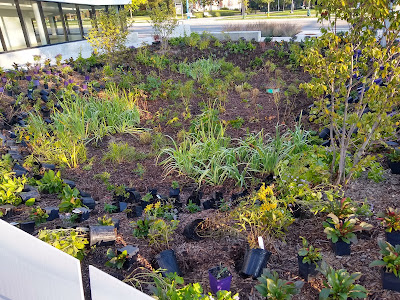We shared their website on our social media, and soon after, we were contacted about installing a rain garden close to our office. The first one using their new program.
The homeowner wanted to help by reducing her runoff and is making steps to become more environmentally responsible with her property - less spraying and more habitat. However, she isn't fond of the wild, "prairie look" and hoped for something "tidy" looking.
Keeping this in mind, much of the basin floor was covered with low growing sedges for a clean palette. As the eye travels towards the back and berm, we added a bit more diversity to try to maximize time with blooming plants, balancing that by keeping the number of different species lower.And, as much as possible she wanted to include lots of edible and food producing plants. We mentioned this fun project earlier!
We do have a fair amount of smaller native plants with edible fruit such as serviceberry and gooseberries, so we used two of each! Although not in this project elderberry, paw paw and hazelnuts would be good native options too. We also included strawberries, asparagus and some herbs.
We were sold out of strawberries, thanks to Iowa Backyard Farmer for these!
A rain barrel was also on the project wish list, too. She chose a barrel that she found online, which matched the house well, but was a little different for us to install.

Since the strawberries are everbearing, and were already growing well, they have produced enough for a treat every few days! 🍓🍓🍓





















































